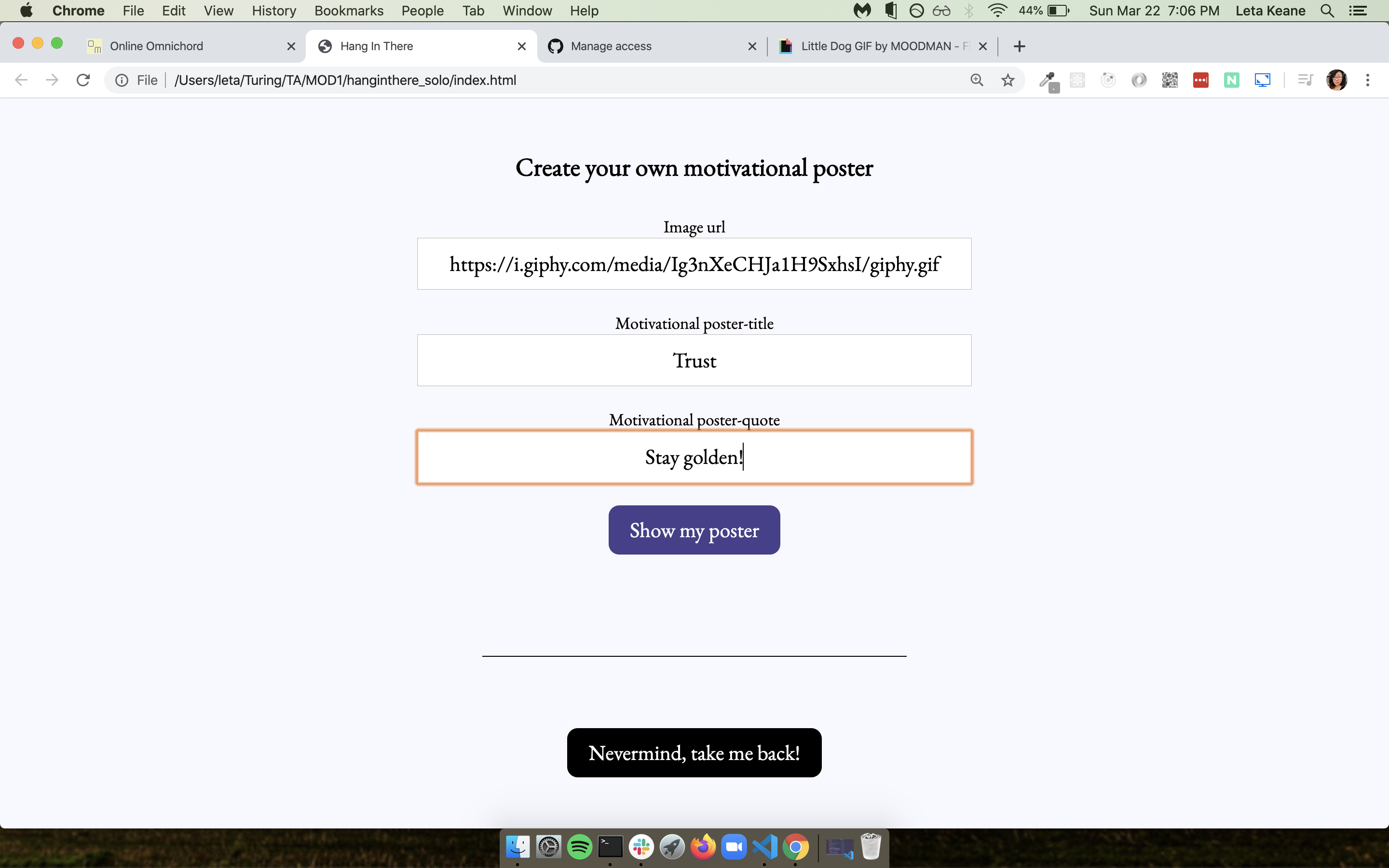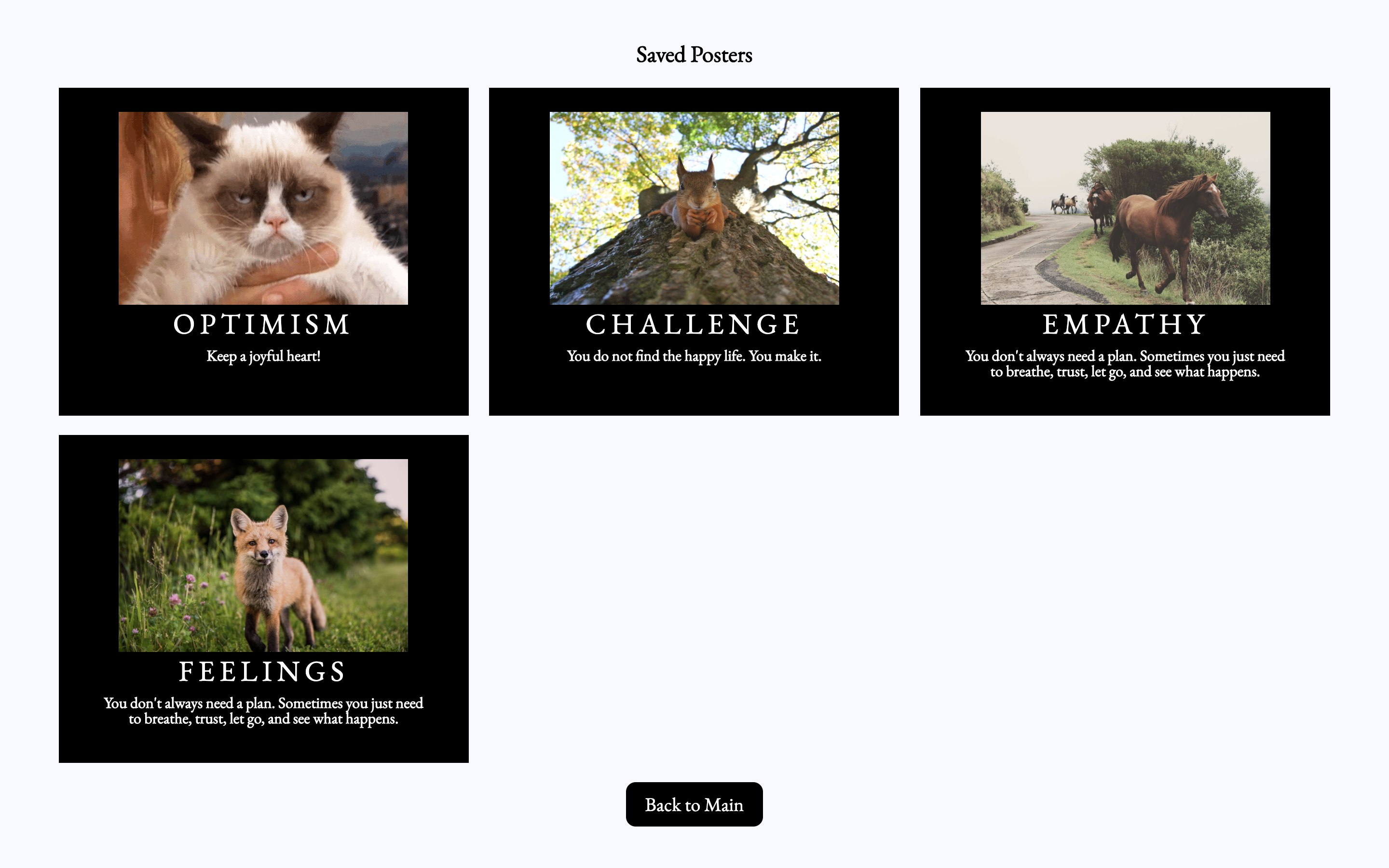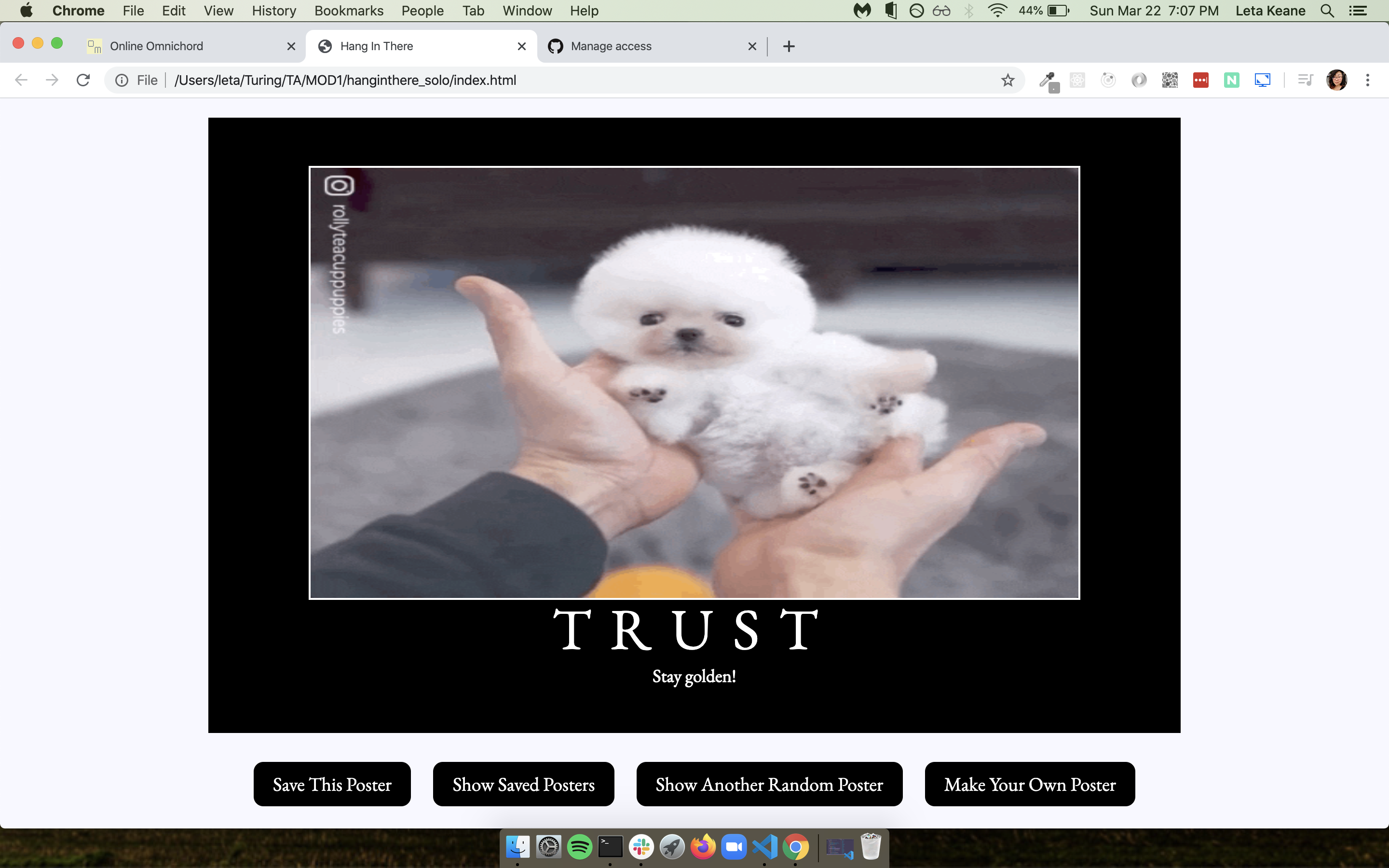Hang In There - Pair
Learning Goals
- Write clean, DRY JavaScript
- Use a provided createPoster function to create your
posters - Manipulate the page after it has loaded adding, removing, and updating elements on the DOM
- Use a provided createPoster function to create your
- Begin to understand the connection between HTML, CSS and JavaScript
- Practice reading, understanding, and using provided code
- Build an understanding of writing code collaboratively
- Document changes with atomic commits & thorough code reviews
- Communicate, troubleshoot, and plan effectively as a team
Overview
Sometimes you need a pick me up. Remember those motivational posters that were all over the place in classrooms and online? We’re going to make our own!
Set Up
To begin, choose one partner to do the following:
- Fork the repository found here: https://github.com/turingschool-examples/hang-in-there-boilerplate/.
- Clone down your new, forked repo. While cloning, name it what you want your project to be named, should not include “boilerplate”.
git clone <url> <newNameYouWantItToHave> cdinto the repository- Open it in your text editor
- Add all project partners and your assigned instructor as collaborators on the repository
Then, as a team:
- Explore the repository to see what’s going on in the code
- What pieces of code might you use to complete iterations, and what pieces will you have to create?
- All of your JavaScript will be written in
domUpdates.js- you will not need to change any other files.
Day 1 Deliverables
By EOD on Kick Off Day: complete the following tasks:
- As a team, read the entire project spec and rubric
- As a team, complete the Norming Form
- Complete this project submission form to ensure your project manager has the following links:
- the forked GitHub repo
- the GitHub Pages deployed site
- Instructions for deploying: Repo Settings » Pages » Select the
mainbranch as your Source branch » Save » Send us the URL they give you in the pop up that says “Your site is ready to be published at [URL]”
- Instructions for deploying: Repo Settings » Pages » Select the
- Add all teammates and your assigned instructor as collaborators to your forked repository
Progression
Iteration 0 - Main Page

- When the page loads, we should see a poster with a randomly selected image, title, and quote
- Every time the user clicks the Show Random Poster button, a new random poster is displayed.
Iteration 1 - Switching Views
Form view:

Saved posters view:

- When a user clicks the “Make Your Own Poster” button, we should see the form, and the main poster should be hidden
- When a user clicks the “View Saved Posters” button, we should see the saved posters area, and the main poster should be hidden
- When a user clicks the “Nevermind, take me back!” or “Back to Main” buttons, we should only see the main poster section
- In summary: Be able to switch between the three views (main poster, form, and saved posters) on the correct button clicks
Hint: go check out the HTML and CSS files to see how the form and saved posters sections are being hidden in the first place
Iteration 2 - Creating a New Poster
Result after clicking Show My Poster button:

- On the new poster form view, users should be able to fill out the three input fields and then hit the Show My Poster button
- When the Show My Poster button is clicked, several things will happen:
- Use the values from the inputs to create a new, unique poster object (part of your data model)
- Save the submitted data into the respective arrays (image URL into the images array, etc - all part of your data model) so that future random posters can use the user-created data
- Change back to the main poster view (hiding the form view again)
- Use the new, unique poster object (part of your data model) to display the newly created poster image, title, and quote in the main view on the DOM
Hint!
Is something weird happening when you click the button? Try googling event.preventDefault()!
Iteration 3 - Saving & Viewing Posters
- When a user clicks the “Save This Poster” button, the current main poster will be added to the
savedPostersarray. - If a user clicks the “Save This Poster” more than once on a single poster, it will still only be saved once (no duplicates)
- When a user clicks the “Show Saved Posters” button, we should see the saved posters section
- All the posters in the
savedPostersarray should be displayed in the saved posters grid section
Iteration 4 - Deleting Saved Posters
- From the saved posters view, if a user double clicks a saved poster, it will be deleted
- HTML
onclickattributes should not be used in any HTML code - all functionality should be through JavaScript.
- HTML
Hint: How will you update the data model to achieve this?
Optional Extensions - Gettin’ fancy
Here’s a list of possible extensions to implement - but ONLY IF your team has completed all the previous iterations AND have cleaned up your code to make it DRYer and more readable.
You are welcome to add your own extensions. Be sure they are thoughtful in terms of UX/UI, and that they do not break any prior functionality.
- Implement data validation and error handling into the form (disable button, provide error messages if data entered is not correct, etc)
- In the main poster view, allow users to click each piece of the poster (image, title, quote) to update just that piece with another random item from the appropriate array
- When a user single clicks a saved poster, create a modal to view it larger
- Allow users to drag and drop saved posters into whatever order they want them to appear
Notes on Project Feedback
The rubric below serves as a guide for both students and instructors.
Students:
- It should be used as a reference throughout the project to keep on track and guide learning.
- It should also be used by students to self-assess their work.
Instructors:
- It should be used to evaluate the project at its final due date/time.
- It should be a guide to provide relevant feedback to students so they can grow and improve in the areas that need deeper understanding.
Projects as Learning Tools
When projects are graded, we want you to view the evaluation + feedback as a means to inform your learning, rather than as static “grades”. Feedback from instructors will focus on areas where you have an opportunity to deepen your understanding.
The evaluation will provide feedback by answering the only important question:
Does the project demonstrate student understanding of the learning goals & concepts?
Projects will answer that question, being marked as yes, not yet, and wow. Similarly, each section of the rubric (see below) will have yes/not yet/wow markings, helping you understand your progress and growth in specific areas.
The overall project outcome (yes, not yet, wow) is determined by “averaging” each section’s outcome. You can think of a “yes” being worth a 1, a “not yet” being worth a 0, and a “wow” being worth a 2.
For this project, an average of 0.5 is considered a yes - a passing project that demonstrates good student understanding! An average of 1+ is considered a wow. Anything below a 0.5 is considered a not yet - a project that indicates that the concepts have not been fully understood (see note in the section below).
 A important note about the possible outcomes
A important note about the possible outcomes
Rubric
This project has 3 evaluated concepts:
- JavaScript
- Workflow & Professional Habits
- Reading Code
And evaluation of these concepts is assisted through the final graded section:
- Functionality (we can’t properly assess the 3 main concepts if there is not enough work to grade)
JavaScript
This project gives the team room to practice the following JavaScript concepts:
- Functional Programming concepts such as pure functions
- DOM (Document Object Model) manipulation
- Style
- SRP (Single Responsibility Principle) and DRY (don’t repeat yourself) conventions
- Readability - semantic naming, consistency, conciseness
Competency & understanding of these concepts can be demonstrated in many ways. The following examples are not checklists to complete! They are illustrations to guide your team as you develop this project and continue your learning.
 Functional Programing competency examples
Functional Programing competency examples
 DOM Manipulation competency examples
DOM Manipulation competency examples
 JavaScript Style competency examples
JavaScript Style competency examples
Each of these “subsections” are not distinct; they are all taken into consideration when the outcome for JavaScript is determined.
Workflow & Professional Habits
This project gives the team room to practice the following skills:
- Collaboration
- Git
- GitHub
Competency & understanding of these concepts can be demonstrated in many ways. The following examples are not checklists to complete! They are illustrations to guide your team as you develop this project and continue your learning.
 Collaboration competency examples
Collaboration competency examples
Important Note on Collaboration and Professionalism:
Every team member is expected to fully participate, contribute, communicate and collaborate with the team throughout the entirety of this project. Failure to do so can result in an individual failing the project, even if the group/project is otherwise passing.
 Git competency examples
Git competency examples
 GitHub competency examples
GitHub competency examples
Each of these “subsections” are not distinct; they are all taken into consideration when the outcome for Workflow and Professional Habits is determined.
Reading Code
This project gives the team room to practice the following skills:
- Reading code written by someone else (provided boilerplate)
- Effectively making use of existing code
Competency & understanding of these concepts can be demonstrated in many ways. The following examples are not checklists to complete! They are illustrations to guide your team as you develop this project and continue your learning.
 Reading Code competency examples
Reading Code competency examples
Functional Expectations
Functionality is the least important piece of the rubric. It’s included because it is another benchmark to gauge proficiency. However, you should not pursue functionality at the expense of code quality or the learning/growth of all team members.
This means, we DO NOT want to see:
- Code that pursues extensions but is sloppy
- One or both team members do not understand every single line of code
- One or both team members skips the problem solving process (pseudocoding, talking out the problem, articulating, planning) in the pursuit of completing functionality
Well-refactored, thoughtful code is better than sloppy extra features.
 Functionality competency examples
Functionality competency examples
Feedback
A few days after the due date, your team will receive feedback about the project’s average outcome (yes/not yet/wow), as well as each section’s outcome. You will also receive a few pieces of team-specific feedback for each section (things done well, things to improve on for the current/next project).
Common feedback to all projects will also be shared with the cohort. There will be time in the calendar to review these items and figure out how to apply your learning to your current and future work!